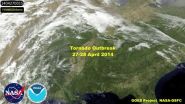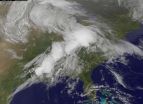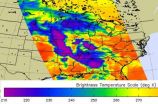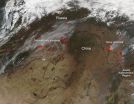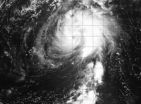(Press-News.org) VIDEO:
This animation of NOAA's GOES-East satellite data shows the development and movement of the weather system that spawned tornadoes affecting seven central and southern US states on Apr. 27-28, 2014....
Click here for more information.
NASA has just released an animation of visible and infrared satellite data from NOAA's GOES-East satellite that shows the development and movement of the weather system that spawned tornadoes affecting seven central and southern U.S. states on April 27-28, 2014. NASA's Aqua satellite captured infrared data on the system that revealed powerful storms, high into the troposphere.
This storm system generated reports of tornadoes from Nebraska, Kansas, Iowa, Oklahoma, Arkansas, Louisiana, and Mississippi.
Coupled with local weather observations, soundings, and computer models, data from satellites like NOAA's Geostationary Operational Environmental Satellite or GOES-East (also known as GOES-13) gives forecasters information about developing weather situations. In real-time, the NOAA's GOES-East satellite data in animated form showed forecasters how the area of severe weather was developing and moving.
NOAA's GOES-East satellite sits in a fixed orbit in space capturing visible and infrared imagery of weather over the eastern U.S. and Atlantic Ocean. The GOES-East satellite is operated by the National Oceanic and Atmospheric Administration. NASA/NOAA's GOES Project at the NASA Goddard Space Flight Center in Greenbelt, Md. created the animation of GOES-East satellite data that covered the period during the tornado outbreak.
The GOES-East animation of visible and infrared imagery runs 31 seconds. The animation begins on April 27 at 00:15 UTC (April 26 at 8:15 p.m. EDT) and runs through April 28 at 14:15 UTC/10:15 a.m. EDT. By 14:45 UTC/10:45 a.m. EDT on April 27 the animation shows the squall line of thunderstorms developing.
To create the video and imagery, NASA/NOAA's GOES Project takes the cloud data from NOAA's GOES-East satellite and overlays it on a true-color image of land and ocean created by data from the Moderate Resolution Imaging Spectroradiometer (MODIS) instrument that flies aboard NASA's Aqua and Terra satellites. Together, those data created the entire picture of the storm system and show its movement.
A NASA satellite also captured an image of the storm, collecting infrared data on it as it passed overhead on April 27. At NASA's Jet Propulsion Laboratory (JPL) in Pasadena, Calif. a false-colored image was created of the storm system using data gathered by the Atmospheric Infrared Sounder (AIRS) instrument that flies aboard NASA's Aqua satellite on April 27 at 18:59 UTC (1:59 p.m. CDT). The AIRS image showed very cold cloud top temperatures indicating that the thunderstorms had strong uplift that pushed cloud tops to the top of the troposphere. Some of those thunderstorms had cloud tops as cold as 200 kelvin (-99.6 F/-73.1C). Temperatures drop to just under 220 degrees kelvin at the top of the troposphere (and where the tropopause begins).
"AIRS data shows spatial extent of strong convection [rapidly rising air that condenses and forms clouds] in the slow-moving severe storm system that spawned tornadoes in Arkansas, Oklahoma and Iowa," said Ed Olsen, creator of the AIRS image at NASA JPL. The AIRS image showed the thunderstorms with coldest cloud top temperatures stretched from eastern Nebraska, through western Iowa, western Missouri, northern Arkansas and southeast into northern Mississippi and Alabama.
According to the Examiner.com, the National Weather Service's Storm Prediction Center counted 31 tornadoes on Sunday, April 27, however, that number is being refined as reports are analyzed.
CBS News reported that one tornado touched down 10 miles west of Little Rock, Arkansas around 7 p.m. CDT (at around 22:02 UTC in the GOES animation) and stayed on the ground for about 80 miles passing near several suburbs north of the city. That tornado was reported to be one-half mile wide.
The same system that spawned these tornadoes is expected to bring the possibility for severe weather further east on April 28 from Cincinnati, Ohio to New Orleans, La. For more information about current risks for severe weather, visit NOAA's Storm Prediction Center at: http://www.spc.noaa.gov.
GOES satellites provide the kind of continuous monitoring necessary for intensive data analysis. Geostationary describes an orbit in which a satellite is always in the same position with respect to the rotating Earth. This allows GOES to hover continuously over one position on Earth's surface, appearing stationary. As a result, GOES provide a constant vigil for the atmospheric "triggers" for severe weather conditions such as tornadoes, flash floods, hail storms and hurricanes.
INFORMATION:To download the GOES animation: http://goes.gsfc.nasa.gov/pub/goes/QTmovies/140427-8_tornados.mov
For updated information about the storm system, visit NOAA's NWS website: http://www.weather.gov
For more information about GOES satellites, visit: http://www.goes.noaa.gov/ or goes.gsfc.nasa.gov/
Satellite movie shows US tornado outbreak from space
NASA and NOAA satellites capture visible and infrared data on storm system
2014-04-28
ELSE PRESS RELEASES FROM THIS DATE:
NIH scientists establish monkey model of hantavirus disease
2014-04-28
WHAT: National Institutes of Health (NIH) researchers have developed an animal model of human hantavirus pulmonary syndrome (HPS) in rhesus macaques, an advance that may lead to treatments, vaccines and improved methods of diagnosing the disease. The study, conducted by researchers at NIH’s National Institute of Allergy and Infectious Diseases (NIAID), is published in the Proceedings of the National Academy of Sciences.
People become infected with hantaviruses by inhaling virus from the urine, droppings or saliva of infected rodents. This infection can progress to HPS, ...
A water test for the world
2014-04-28
HAMILTON, April 28, 2014 – Inspiration can come in many forms, but this one truly was a breath of fresh air.
A group of McMaster researchers has solved the problem of cumbersome, expensive and painfully slow water-testing by turning the process upside-down.
Instead of shipping water to the lab, they have created a way to take the lab to the water, putting potentially life-saving technology into the hands of everyday people.
The team has reduced the sophisticated chemistry required for testing water safety to a simple pill, by adapting technology found in a dissolving ...
Technological advancements extend survival of transplanted hearts across species
2014-04-28
The use of transplant organs from animals (xenotransplantation) could help to compensate for the shortage of human organs available for transplant. NIH researchers have demonstrated that by using hearts from genetically engineered pigs in combination with target-specific immunosuppression of recipient baboons, organ survival can be significantly prolonged. This has potential for paving the way for the use of animal organs for transplantation into humans.
Toronto, ON, Canada, April 28, 2014 – Cardiac transplantation is the treatment of choice for end stage heart failure. ...
Disney Researchers use 3-D printing to produce interactive speakers of any shape
2014-04-28
Forget everything you know about what a loudspeaker should look like. Scientists at Disney Research, Pittsburgh have developed methods using a 3D printer to produce electrostatic loudspeakers that can take the shape of anything, from a rubber ducky to an abstract spiral.
The simple speakers require little assembly, but even those few manual steps might be eliminated in the future, said Yoshio Ishiguro, a Disney Research, Pittsburgh post-doctoral associate. "In five to 10 years, a 3D printer capable of using conductive materials could create the entire piece," he predicted.
The ...
Well-informed patients key to accepting gene-based drug dosing
2014-04-28
A new study out of Western University (London, Canada) illustrates the need for a lot more education around pharmacogenetics (PGx) –the study of how a patient's genes can affect drug reaction and dosage. PGx promises to optimize patient response to therapy, but this is the first study to really investigate how patients perceive this kind of genetic testing, and whether those perceptions differ when it comes to parents and their children. The research, led by Dr. Michael Rieder of Western's Schulich School of Medicine & Dentistry is published in the journal Pediatrics.
"Pharmacogenetic ...
The thin-crusted US Sierra Nevada Mountains: Where did the Earth go?
2014-04-28
Boulder, Colo., USA – In an addition to Geosphere's ongoing themed issue series, "Geodynamics and Consequences of Lithospheric Removal in the Sierra Nevada, California," Craig H. Jones of the University of Colorado Boulder and colleagues examine the seismological study of the entire extent of the U.S. Sierra Nevada range using seismograms collected in the Sierra Nevada EarthScope field experiment from 2005 to 2007.
The southern Sierra Nevada is known to have unusually thin crust for mountains with such high elevations (peaks higher than 4 km/14,000 ft, and average elevations ...
Precise brain mapping can improve response to deep brain stimulation in depression
2014-04-28
Experimental studies have shown that deep brain stimulation (DBS) within the subcallosal cingulate (SCC) white matter of the brain is an effective treatment for many patients with treatment-resistant depression. Response rates are between 41 percent and 64 percent across published studies to date.
One of the proposed mechanisms of action is the modulation of a network of brain regions connected to the SCC. Identifying the critical connections within this network for successful antidepressant response is an important next step.
A new study using MRI analysis of the ...
Wildfire outbreak in far eastern Russia
2014-04-28
According to the Voice of Russia, "As of Saturday morning, in Russia continue 103 wildfires at 27,412 hectares, including big 26 wildfires in the Far East and in Siberia. On Friday, 147 new fires began at 12,509 hectares, and 150 were extinguished at 5,437 hectares. Emergency situation has been introduced in the regions with most complicated situations - in the Amur region, in the Maritime and Baikal territories. This was according to the EMERCOM's (Emergency Control Ministry) spokesperson Alexander Drobyshevsky.
Satellites (such as Aqua and Terra) have located "1,587 ...
Cyberspace scholarship nets higher grades, better thinking for class Facebook group
2014-04-28
University students who used a Facebook group as part of a large sociology class did better on course assignments and felt a stronger sense of belonging, according to a Baylor University study.
The study has implications for the challenge of teaching large classes, a growing concern for higher education. Classes numbering hundreds of students — particularly in introductory courses — have become common at many universities, said researchers Kevin Dougherty, Ph.D., associate professor of sociology in Baylor's College of Arts and Sciences, and Brita Andercheck, a doctoral ...
Newborn Tropical Storm Tapah threatens Saipan and Tinian
2014-04-28
A tropical storm warning is in force for Saipan and Tinian as Tropical Storm Tapah moves north through the Northwestern Pacific Ocean on April 28. When NASA-NOAA's Suomi NPP satellite passed overhead and, imagery revealed a developing eye in Tapah.
In addition to the tropical storm warning, a typhoon watch is in effect for Alamagan and Pagan as Tapah is expected to continue in a generally northerly direction over the next couple of days. A typhoon watch means typhoon force winds of 74 mph or greater are possible within 48 hours. A tropical storm warning means tropical ...
LAST 30 PRESS RELEASES:
Electrodes created using light
Second-hand gift-giving is a well-deliberated decision
How human interaction drove evolution to make bears less aggressive
National Poll: Few parents offer teens guidance on healthy eating during holiday season
Cannabis derivatives could provide new ovarian cancer treatments
Raising strong yeast as a petroleum substitute
Clues to the origin of hot Jupiters hidden in their orbits
Canada’s reduced pledge to Global Fund will impact domestic health
1 in 4 children with major traumatic injuries not cared for in pediatric trauma centres
Duke and Duke-NUS’ joint cross-population research to uncover "East-West" differences in disease and care
Scientists to ‘spy’ on cancer- immune cell interactions using quantum technology breakthrough
Tech savvy users have most digital concerns
Making lighter work of calculating fluid and heat flow
Normalizing blood sugar can halve heart attack risk
Lowering blood sugar cuts heart attack risk in people with prediabetes
Study links genetic variants to risk of blinding eye disease in premature infants
Non-opioid ‘pain sponge’ therapy halts cartilage degeneration and relieves chronic pain
AI can pick up cultural values by mimicking how kids learn
China’s ecological redlines offer fast track to 30 x 30 global conservation goal
Invisible indoor threats: emerging household contaminants and their growing risks to human health
Adding antibody treatment to chemo boosts outcomes for children with rare cancer
Germline pathogenic variants among women without a history of breast cancer
Tanning beds triple melanoma risk, potentially causing broad DNA damage
Unique bond identified as key to viral infection speed
Indoor tanning makes youthful skin much older on a genetic level
Mouse model sheds new light on the causes and potential solutions to human GI problems linked to muscular dystrophy
The Journal of Nuclear Medicine ahead-of-print tip sheet: December 12, 2025
Smarter tools for peering into the microscopic world
Applications open for funding to conduct research in the Kinsey Institute archives
Global measure underestimates the severity of food insecurity
[Press-News.org] Satellite movie shows US tornado outbreak from spaceNASA and NOAA satellites capture visible and infrared data on storm system
